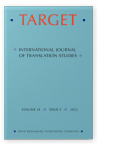Vol. 34:4 (2022) ► pp.628–652
Anticipation and timing of turn-taking in dialogue interpreting
A quantitative study using mobile eye-tracking data
This article presents the results of an exploratory study on the timing of turn-taking in face-to-face dialogue interpreting based on a corpus of interpreted interactions that were recorded with mobile eye-trackers. Our aims were to: (1) investigate the timing of interpreters’ turns in dialogic interaction; and (2) identify features that have an impact on interpreters’ turn-taking speed. These include input processing factors (including turn type and turn duration) and gaze, which have been shown to play an important role in turn-taking. The analysis shows that, although interpreters in our study tend to orient to the maxim ‘one speaker at a time’, turn transitions between the primary speaker and the interpreter contain more gaps and longer overlaps than have been found for same-language interactions. It also shows that the type of turn produced by the primary speaker (question vs. non-question), the primary speaker’s speech rate, and, to a certain extent, turn duration affect the interpreter’s turn-taking speed. Thus, the present study contributes to a better understanding of the processes that impact the timing of turn-taking in face-to-face dialogue interpreting.
Article outline
- 1.Introduction
- 2.Timing of turn-taking in interaction
- 3.Method and data
- 4.Analyses
- 4.1Timing of turn-taking in dialogue interpreting
- 4.2Factors explaining turn-taking speed
- 5.Discussion
- 6.Conclusion
- Notes
-
References
